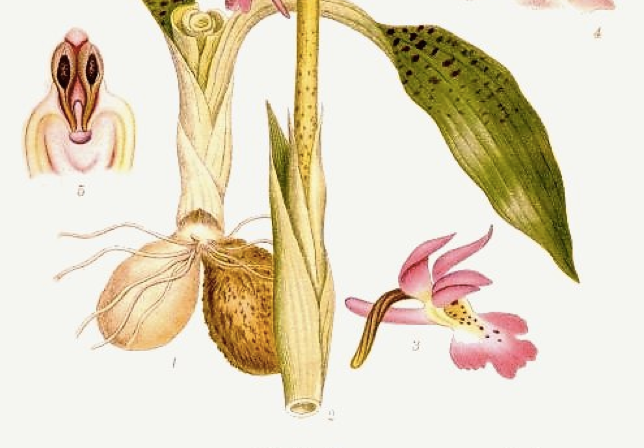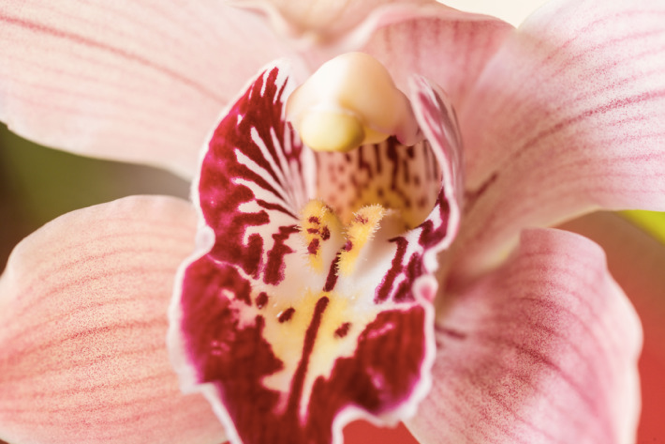Daisy Butcher
Femininity, flowers and death have long been interconnected in the myths, folktales and stories that have captivated cultures across the globe. In their beauty and delicacy, plants can be a source of joy, but in their poisonous, thorned, or carnivorous aspects, they can also inspire fear. Nowhere are these two registers so diametrically opposed as in the orchid, an exotic flower with an extensive cultural history. The orchid plays an unexpectedly influential role in popular media, most recently in Netflix’s first series of Stranger Things. The monster in Stranger Things, the demogorgon, who resides in the ‘Upside Down’ that mirrors and shadows the town of Hawkins, Indiana, has a head that opens up like an orchid flower. But this is no ordinary bloom: the demogorgon’s flowering orchid reveals labial lips with teeth as it captures and feeds on children.
Perhaps more than any other flower, the orchid has enjoyed a long history of representation in fine art and literature. During the nineteenth century, with the rise of imperial global networks, the orchid flower became a botanical obsession, termed ‘orchidelirium’ or ‘orchidmania’.[1] Thousands of specimens were culled from jungles across the globe—from Colombia to the Philippines—and imported to temperate seats of empire in Britain and America. As orchids became an obsession and plaything for the rich, there was a sudden boom in horror stories revolving around killer plants and flowers that poisoned—or even ate—their collectors. Arthur Conan Doyle, Louisa May Alcott and H.G. Wells wrote such stories featuring Venus fly traps or orchids that would kill their unwitting cultivators. (This theme would be taken up in the twentieth century with Little Shop of Horrors.)
But why the fascination with this particular flower as an inspiration for fanaticism and horror? To understand this cultural trend, we must consider the bodily implications of the orchid’s appearance, notably its association with genitalia. The word ‘orchid’ comes from the Greek myth of Orchis, who as punishment for his rapaciousness is torn apart by Bacchantes. When his father begs the Gods for mercy, they turn him into a flower to perpetuate his name in lasting infamy.[2] As the orchid was named from the Greek word for testicle because of the shape of its twin tubers and bulb (hence orchidectomy), this punishment suggested his degradation as a sexual deviant, no better than a sex organ.

Fig. 1. Twin tubers.
And yet, despite this history in etymology and myth, there can be no mistake that the appearance of the orchid is distinctly more vaginal than phallic or testicular. Botanists acknowledge this similarity in their description of the bloom: the lower petals are called the labellum, which stems from the Latin labium (lips), the root for labia. The anther cap, meanwhile, bears a striking resemblance to the clitoral hood. Together with its exotic, tropical origins and its preference for hot and steamy rooms, the orchid, therefore, is simply oozing with the imagery of female sexuality.

Fig. 2. Labellum and cap.
Beyond the orchid’s particular associations with female anatomy, Erich Neumann argues, the plant symbolizes two extremes in femininity. Like the female procreative power in psychoanalysis—perceived as either the immaculate womb or the vagina dentata—plants both represent life and growth (the protective mother earth), and act as a reminder of mortality (the changing seasons, hangings of people from branches, the cross, wooden coffins, gallows and the stake).[3] Neumann’s strand of psychoanalysis, therefore, describes the rich botanical metaphors that have traditionally connected femininity, sex and death.
What’s especially curious about the orchid’s appearance in Stranger Things, however, is that its monstrous representations go farther than merely exploiting the death-dealing flower’s symbolism as a femme castratrice. Certainly, the demogorgon’s orchid head recalls the vagina dentata from psychoanalysis—but with the particular threat that this monster poses to teens and children, the fatal flower is also an inversion of ideal maternity.

‘Chapter Eight: The Upside Down.’ Stranger Things: Season One. Writ. & Dir. Matt Duffer and Ross Duffer, 2016. Netflix. Online.
Moreover, the feminine’s draining aspect is also accentuated here in terms of the poisonous woman who saps away the life of man—a trope that the abstract feminine shares with carnivorous plants and toxic flowers, herbs, and mushrooms. Mushrooms/fungi are particularly important to Stranger Things, as upon entering the Upside Down the characters notice visible spores floating around in the air. This fungal environment adds to the motif of botanical poisoning, while the spore elements also speak to the parasitic and contagious nature of the sexual feminine. The demogorgon’s particular form of monstrosity also exploits the fear of gender-crossing (or what critic Erin Harrington calls ‘gynaehorror’) inspired by the vagina dentata, which displays both the penetrative phallic fangs and the fleshy, soft orifice of the labial lips.[4] The mother demogorgon is rendered especially terrifying as she breaks gender barriers to spread her own seed: in her ability to self-replicate, the monster appropriates the role of the phallus. Will Byers, the missing boy in the series, ends up being impregnated with the demogorgon’s spawn as he regurgitates a worm/slug into the sink. Even the moment of creation of this new life-form is gender-crossing: the worm/slug, of course, is another symbol of the phallus or sperm, while Will’s intermittent flashing back to the Upside Down realm evokes the feminine, womb-like associations of the abyss, the underworld, and darkness.

‘Chapter Eight: The Upside Down.’ Stranger Things: Season One. Writ. & Dir. Matt Duffer and Ross Duffer, 2016. Netflix. Online.
The demogorgon’s lair in the ‘Upside Down’ is mysterious, a shadow dimension associated with the feminine in psychoanalysis, which is linked to imagery that is mysterious, dark, and deep. Throughout Stranger Things, the fear of the abyss is a key motif that gestures to the horror that psychoanalysis explains as the entry into the unknown – crucially, a horror that is synonymous with fear of the feminine. The brave hero must explore the mysterious abyss, losing himself inside the void and relinquishing control to be completely at her mercy.
Even the very entrances to The Upside Down are a form of abjected body horror, with fleshy, red, gaping orifices leading from real-world locations—the basement of the experiment facility where Eleven was found and the trees in the forest—to this other world. At the military experimental facility, the entrance is pulsating and alive, and the Sheriff and Will Byers’ mother have to force their way in. The uterine imagery of the entrance is strong, suggesting a pseudo-birth, since the bursting through of the heroic pair recalls cutting through an amniotic sac. In fact, this scene represents a caesarian procedure whereby they aim to extract Will Byers from the evil womb of the vagina dentata. Meanwhile, reversing the adults’ path into the Upside Down, the demogorgon tears its way from the subterranean into the human realm through another uterine opening in the Byers’ home; it thus also resembles a nightmarish foetus or a monstrous birth. Moreover, entering the Upside Down can also be read as breaking the hymen: the adult pair encroach into the feminine realm, seemingly the first to do so successfully without being kidnapped by the monster. The vaginal and plant connection is important here: not only does the bodily merge with the plant at the tree entrances, but the imagery of the plant as hymen conveys a fear of the poisonous. In many cultures, hymeneal blood was thought to have magical properties and to be toxic. [5]

‘Chapter Eight: The Upside Down.’ Stranger Things: Season One. Writ. & Dir. Matt Duffer and Ross Duffer, 2016. Netflix. Online.
The demogorgon and its realm therefore portray many of the psychoanalytic symbols surrounding the archetypes of the Terrible Mother and vagina dentata. It is enlightening to highlight the ways in which Stranger Things plays upon the concept of abject femininity. The show’s creators have spoken about being inspired by horror films of the 1970s and 80s, and indeed, the Demogorgon and the Upside Down have many precedents in horror, such as the Xenomorph from the Alien films. As a psychoanalytic reading of Stranger Things reveals, contemporary horror exploits sexual anxieties, revealing the shadow side of something that is meant to be pleasant and safe, like the mother, as something more sinister—an infanticidal killer.
Daisy Butcher is a PhD candidate at the University of Hertfordshire, UK. She is developing research focusing on monsters in popular culture from the Victorian penny dreadful to modern day and how these often express anxieties surrounding the female body and femininity. She compares the medical methods used to ‘treat’ and subdue women during the nineteenth century and how this is mirrored in monster slaying narratives, and is particularly interested in how the hyperbolic feminine is often a case of kill or cure.
Works Cited
[1] Endersby, Jim, Orchid: A Cultural History (Chicago: University of Chicago Press, 2016), 65.
[2] Ibid., 59
[3]Neumann, Erich, The Great Mother: An Analysis of the Archetype (New York: Princeton University Press, 1963), 49-50.
[4] Harrington, Erin, Women, Monstrosity and Horror Film: Gynaehorror (Oxon: Routledge, 2018).
[5] Rees, Emma. L.E., The Vagina: A Literary and Cultural History (London: Bloomsbury, 2013), 59.


